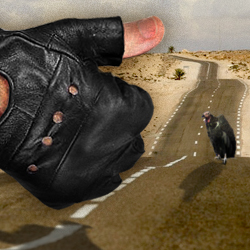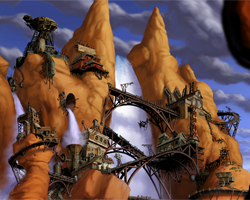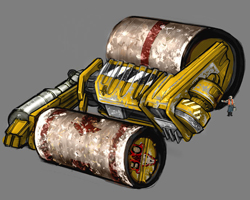Missing Pressumed? (II)
The second part on our cancelled games article series focuses on the true story of Full Throttle 2, in both of its versions, backed with declarations byt the first Art Director of the project: Bill Tiller
# Paco García |

Full Throttle: Payback
In 1995, LucasArts released again an aboslute hit in the adventure genre that, as every title in the company’s history has, instantly became a classic, although this time some people had their reservations, seeing in Full Throttle something different from what the company had us all used to: Full Throttle had quite a lot of cutscenes and short but frequent action scenes, so people were afraid of its concept, foreseeing the presence of a hybrid; a fear mainly caused by senseless debates on printed magazines; the same magazines that years later welcomed with open arms the many examples of genre mixtures that were eventually created.

The fact is that, in any case, Full Throttle was well received by most as a new masterpiece, and was supported by the many fans that were unwilling to discuss the ins and outs of Tim Schafers’ concept of the game. And it certainly is praiseworthy that, with a plot like this game had, far from suitable for an aventure game, with the bikes, the aggressiveness of the bikers and their stories of revenges, brawls and gangs, eventually came to be the classic that it is today. Of course, it would have been much easier to base the game on the fists rather than on puzzles, and instead of developing a good example of storytelling, to merely introduce a bad pretext of a story to support the punch-ups of virile truckers beating one unfortunate Polecat. But maybe because back then the adventure game genre was a fairly safe number to bet on, or perhaps because the genre had not yet suffered from the poisoning we perceive today as a constant, or even because people back then simply took things with more enthusiasm than they do today, Full Throttle ended up being a model to follow.
So much so, that LucasArts decided to listen to the many fans asking for a sequel and they got to work with it, even though it was many years after the original game, with a new team and with lots of changes directed towards its targetting to the console market. With these premises, Full Throttle: Payback began to forge.
Larry Ahern was put in charge of the project; he was now a personality after Curse of Monkey Island, and he worked side by side with Tim Schafer in the first game, so he knew the franchise pretty well. On his side, Bill Tiller, a wide renowned artist and now the leader of Autumn Moon, was named Art Director of the project.
Payback began its brewing at the beginning of the current decade, a time that, as many of you will remember, was not one of the most fruitful periods of time for our genre as we know it –in fact many hurried to dig its tomb in the search of new formulas of success. The so-called “action adventure” was one of this infallible recipes, yet it still has to define itself completely as a genre. Payback was planned from the beginning as a game included in this particular “family”. We have asked Bill Tiller about the reasons of this decision: “Simon Jeffery, LucasArts president, wanted to do another Full Throttle game after LucasArts got a lot of mail asking for sequels to games … One of these was Full Throttle (the other was Outlaws). But he wanted it to be an action/adventure hybrid for the PlayStation 2 because it would have sold more on that platform and genre than just a straight up adventure game on PC”.

The team in charge of the development was not very happy with the decision of LucasArts’ CEO, as they missed the presence of Tim Schafer: “Tim would have preferred they not make a Full Throttle sequel without him; he had created it and felt strongly connected to it, which I understand. But he was paid by LucasArts to make it and since they paid for it they could do what they liked with it, is how LucasArts saw it. Plus Tim was too busy with Psychonauts to do anything about it anyway”.
In any case, the decision was eventually accepted, and the result is that the game was never actually conceived as an adventure game but rather an odd mixture of genres that, in the case of actually making it, would have raised the voices of some purist or another. Tiller defines what Full Throttle: Payback could have been this way: “A bit of a light RPG and light adventure game with a huge emphasis on brawling and biker combat. We also wanted the player to drive where he wanted, stop, and then walk where he wanted, what people today call Multi Action Genre games like Grand Theft Auto. The setting was still going to be southwestern United States, but I wanted to move it up to the high desert and mountains, so that we could have more mountains, pine trees and maybe even snow. And other part so the game I wanted to take place in canyon lands, and lastly in a desert city. We wanted to know what a city in Full Throttle would look like”.
Continues on next page
Page 1 of 3
